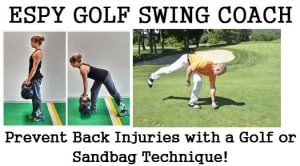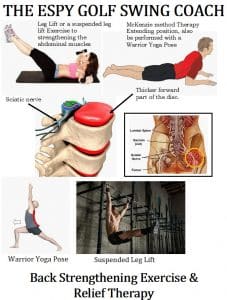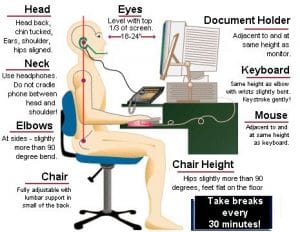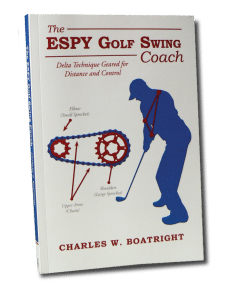
By: Charles W. Boatright
SUBJECT– Maintaining a Safe Work Zone during your daily activities.
ISSUE– Steps one can take to prevent back, shoulder, elbow, and wrist injuries.
QUESTION– How can companies and individuals establish a Safe Work Zone?
One reason ergonomics and a Safe Work Zone is importance for us to incorporate into our daily activities that we have to do is to do the things we want to do. I have played golf with people who had lower back issues and these type of issues severely limit the activities they enjoy engaging in, like golf, baseball, tennis, basketball or other activities.
One of the most important steps that companies and/or individuals can do is to maintain a healthy ergonomic environment by moving the majority of activity into a Safe Work Zone or area. Most of the time, when the term “Safe Work Zone” is used, people think about road construction projects where speed zones are posted and barriers are erected to keep workers safe. But in reality, Safe Work Zones deal with activity at home and on the job, even in an office setting. This is not restricted to just construction or heavy industrial areas.
A Safe Work Zone deals with the area where the majority of a person’s activity should be performed. The importance of establishing a Safe Work Zone is to avoid the following injuries:

- Lower back
- Shoulder
- Elbow
- Wrist
This is probably one of the easiest precautions an individual can take to avoid these major injuries. The Safe Work Zone is designated as a zone between the person’s knuckles, or metacarpals, up to just below their shoulders and the width of the elbows, when extended outward to the sides just below the sternum. This Safe Work Zone is illustrated in the figure below. Ninety percent of a person’s work should take place within this zone. If more work is done outside this zone, the person is exposed to the listed injuries above, among others. The lower back is especially a significant and frequent place for workplace injuries to occur. Another place injuries can occur is with the wrist.

To avoid these injuries, companies and individuals need to restrict most, if not all, repetitive and incidental work or movement to the Safe Work Zone or area. If you are required to work outside of this Safe Work Zone, the individual needs to take precautions. One precaution when bending down is to use the one-step forward method, or another method is to extend one of the legs backward, like how golfers would retrieve their golf ball from the cup. Both of these methods are illustrated below. These two methods will prevent the individual from bending at the waist. Instead, the person wants to bend at the hips. This is how the body is designed to bend, and never bend at the waist.

In the diagram below are the different stages of disc conditions, from a healthy, normal disc to a degenerated disc. Remember, the disc does not have nerve receptors, but the nerve around the disc does. So you won’t necessarily feel if you’ve moved or picked up something wrong until it is too late, even if this is only picking up a newspaper bending at the waist for long period of time.

Back health requires the person to be proactive, in regard to keeping the majority of your work and activity in the Safe Work Zone.

Another precaution a person can take is strengthening their abdominal muscles to help support and stabilize the lower lumbar area. My CASPER Workout Program is designed for a full body workout, but its main focus in on the core muscles. Also, a major back issue is the person’s weight. A good way to measure Body Mass Index (BMI) is to take a string or rope and cut the string or rope length to your height. Fold it in half and measure your waist, your waist should be equal or less than half the length of the string or rope.

To protect the wrists from injuries like carpal tunnel syndrome, the person should avoid prolong positions where the wrists are in the Palmar Flexion, or Dorsiflexion position (shown above), especially while working at the keyboard. You want to maintain a neutral position where the elbows are at or slightly lower than the height of the keyboard as noted below, with a person sitting at their computer.

I will be discussing other safe work practices that a person can use at their computer station in the coming weeks. Most of the time, computer stations aren’t given the consideration they should be given, and people have to endure painful debilitating situations.
If you want a sport activity that you can enjoy the rest of your life and enjoy developing friendships with others, take up the sport of golf. If you have no prior experience, are not proficient at this fascinating game, or like to improve your golf game, purchase your copy of The ESPY Golf Swing Coach from the links below, or visit your local bookstore:
This book is a self-coaching guide that provides basic and advanced fundamentals to help you play golf with confidence and start lowering your handicap.
My book can also be purchased at Edwin Watts Golf Store in Jackson, Mississippi. Phone No. 601-956-8784
820 East County Line Road, Ridgeland, MS 39157
Please take advantage of my SR-925 Diet Program, where I lost 6 inches in my waist in 3- months (FREE of CHARGE) with the CASPER Workout Program, detailed in Section 20 of my book:
Please include an exercise routine in your weekly schedule.
Also, learning The ESPY Golf Swing Coach process is an excellent way to develop Rhythm without experiencing the Blues:

My golf coach, my grandfather the Great Qatspy, H.E. Boatright in 1946 at the North Hills Golf Course, designed by Bobby Jones, Sr.





